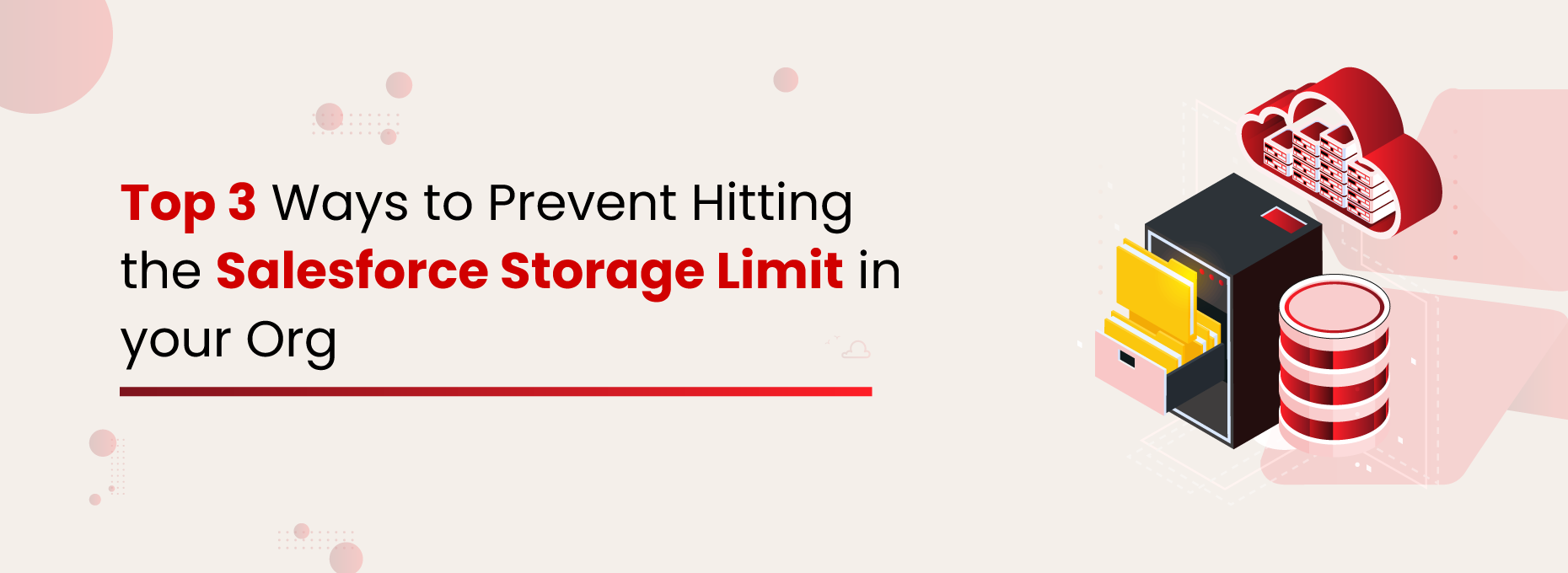In order to keep up with the changing industry trends and evolving customer demands, businesses have to rapidly keep on upgrading & reinventing themselves. They need to offer top-notch services and deliver exceptional experiences to their customers so as to always maintain an edge over their competitors. One of the smartest ways to do this is by investing in tools & technologies that guarantee accelerated growth and higher profit, all the while keeping the expenses in check.
Salesforce is one of the best technology platforms that offers a powerful CRM system to transform sales, marketing, and customer service departments across industries. This powers enterprises to drive innovation, customer success, and revenue. Being a multi-tenant platform, Salesforce always focuses on maintaining top-gear performances of its applications, and in order to achieve this, it has imposed certain limitations. One such limitation is ‘storage’.
Know Your Salesforce Storage
Being a leading CRM, Salesforce offers some storage space within its applications/org. Customer’s data & files that are being generated while using the Salesforce app get stored in the allocated Salesforce storage space.
Salesforce offers three different categories of storage in every org. Let’s have a look at those.
- Data Storage: Salesforce data storage is the home for various data records such as accounts, cases, leads, campaigns, contacts, opportunities, email messages, events, orders, tasks, etc. stored in standard and custom objects.
- File Storage: Salesforce file storage keeps files from notes & attachments, files home, CRM content, Chatter (including user photos), documents, and site.com assets.
- Big Objects: Salesforce Big Objects is the big data-based storage option that is designed to easily hold voluminous amounts of business data.

How Much Storage Space Do You Get in Salesforce?
- Data Storage Space: If you are using Unlimited, Performance, Enterprise, or Professional editions of Salesforce, you will get 10 GB of default data storage space in the org along with 20 MB of additional data storage for each user license. For example, a Professional edition org with 20 users, will receive 10 GB of data storage, plus 20 MB per user which is 400 MB for 20 users. This makes the total data storage 10.4 GB for the company.
- File Storage Space: Similarly all the above Salesforce editions receive 10 GB of file storage space and an additional 20 MB of storage per user license. Salesforce Essentials edition gets 1 GB of file storage space per org. Only the Professional edition has an additional 612 MB (100 MB per user license + 512 MB per license for the Salesforce Content feature license).
- Big Objects: When it comes to Big Objects storage, all the Salesforce editions have allocated storage for 1 million Big Object records per Salesforce Org.
Is the Allocated Storage Sufficient in Salesforce?
Though it largely depends on the usage, in today’s world of data-driven business where enterprises extensively leverage data, the sources of data or file generation have increased. Along with this, the speed of data/file generation has also grown. Considering this, 10 GB of storage is very little for any company. This becomes challenging for businesses that deal with a large number of files, large-size files, more email attachments, and data records.
As per industry trends, companies often run out of their allocated Salesforce data and file storage within a span of 2-3 years even with moderate data/file generation. This could be even lower for businesses that generate more data.
What Happens When Your Salesforce Storage Starts Filling Fast?
When your Salesforce storage starts filling fast, there are several consequences. A few common challenges are:
- The CRM will become bulky. This will impact the app’s performance, user experience & efficiency.
- Meeting regulatory compliance & other data policies becomes tough as storing all the business data within limited storage gets complicated.
- File visibility and accessibility are significantly impacted when seamless collaboration among the users becomes nearly impossible.
- Storage upgrades in Salesforce are incredibly expensive. Both additional data and file storage space come at a higher cost which might impact the overall budget.
How to Increase Your Salesforce Storage Space?
After working with multiple Salesforce customers from diverse industries over a decade, we understood what type of methods most enterprises adopt to better manage their Salesforce storage spaces. Here we have made a consolidated list of the means through which the above-mentioned challenges can be combated and the Salesforce storages can be optimized to a greater potential.
Option 1: Cleaning up Unused Data Manually or Automatically
One of the easiest ways to prevent exceeding the Salesforce storage limits is by purging unnecessary files and data records, either manually or automatically. There are a lot of tools available for these purposes:
- Salesforce’s Mass Delete Wizard: Salesforce’s web-based native mass deletion wizard allows users to delete record types such as cases, solutions, accounts, contacts, leads, products, and activities. Currently, the complete Mass Delete is limited to around 250 records at once and is also limited to the above-named objects.
- Extract Transform Loading (ETL) Tools: Certain ETL tools are used for both data migration and data removal. Popular ETL tools like Salesforce Data Loader can be used to delete both data records and files from the system. Other popular ETL tools include Dataloader.io, Informatica, JitterBit, Integrate.io, etc. Most of these tools are paid for and will always require significant investment and evaluation to ensure they meet the requirements.
- Automatic Deletion: If you don’t want to spend a lot of time and money on removing redundant files and data, several third-party AppExchange applications can be used to automate these tasks. Such applications can easily delete unnecessary files and data from the system, saving both time & manual effort.
Option 2: Purchasing Additional Storage from Salesforce
If your enterprise is not at the liberty of deleting files, attachments, and data records because of long-term retention guidelines, then you can always opt for purchasing additional file or data storage space from Salesforce. But the thing to keep in mind before going for this option is that additional storage, both file & data, is extremely expensive and can essentially throw off your entire budget. Also, this is a recurring cost.
Option-3: Periodic Archiving of Data & Files
Probably one of the most recommended options when it comes to Salesforce storage optimization is secure, long-term data & file archiving. Salesforce archiving solutions can potentially archive old, inactive files and data records from the primary storage to any external Cloud/On-premise storage of your choice. Archiving allows you to free up space in your primary Salesforce storage, reduce your storage expenditure & boost CRM performance while preventing you from hitting the storage limits.
Recommended Option
From the above three options archiving the old data & files from your Salesforce system to a cost-effective long-term secondary storage is the most embraced strategy. In order to perform archiving in Salesforce, there are two options. One, to build a custom archiving app, Second, to look in AppExchange (Salesforce’s app marketplace). Building a custom app requires time, resources, and cost. Looking for a readily available application in AppExchange is always a smart choice.
We offer a complete suite of data & file solutions for Salesforce including data archiving and file management. Using XfilesPro, enterprises can move their files from Salesforce to any external file storage system such as SharePoint, Amazon S3, OneDrive, or Google Drive. Similarly, with our other application DataArchiva, data can be archived from Salesforce data storage both within the Salesforce (Big Objects) or outside of Salesforce using AWS, Azure, Heroku, and GCP platforms.
The above applications can really help you address Salesforce storage limitations without upgrading storage space. This will also ensure cost reduction, performance enhancement, compliance management, efficient document management, and easy file collaboration. Both applications are decorated with future-ready features that can transform your Salesforce data & file management experience.
To know more about these applications, get in touch with our Salesforce storage experts





